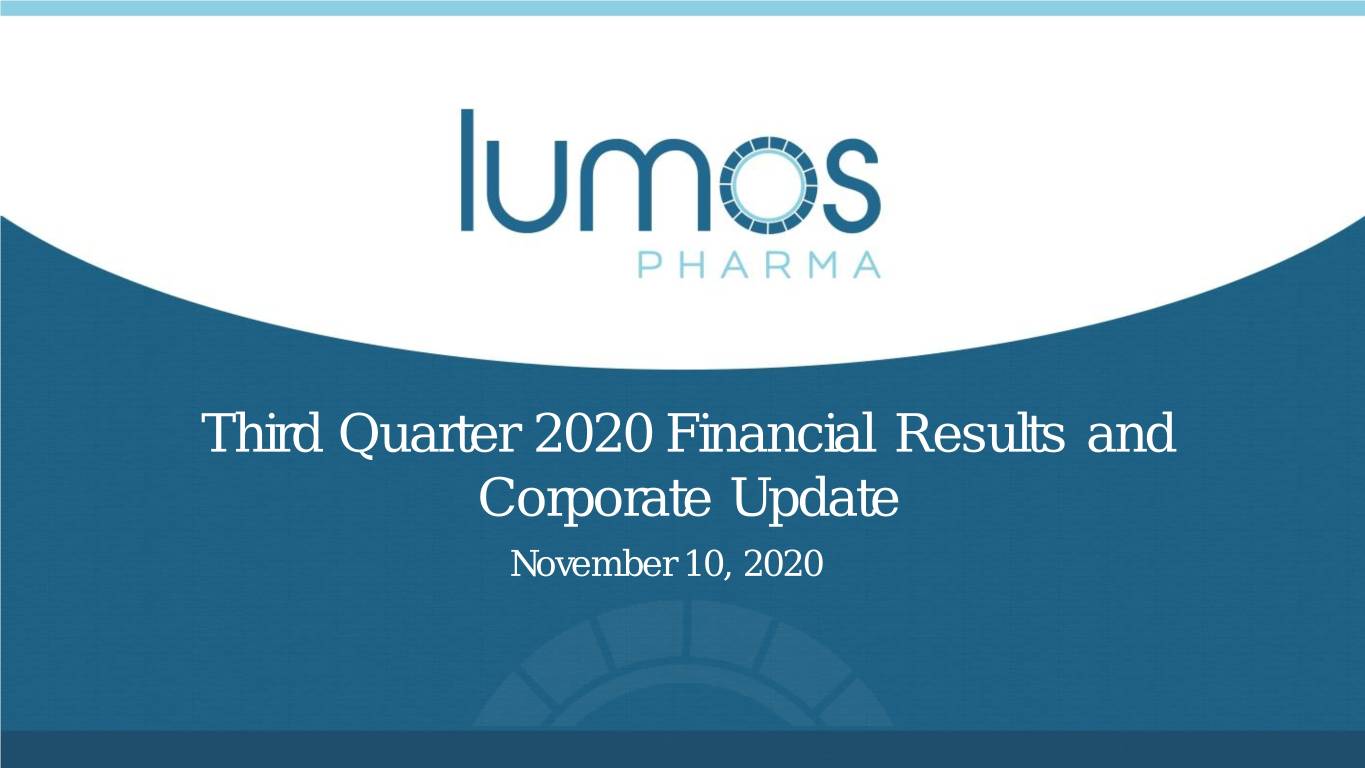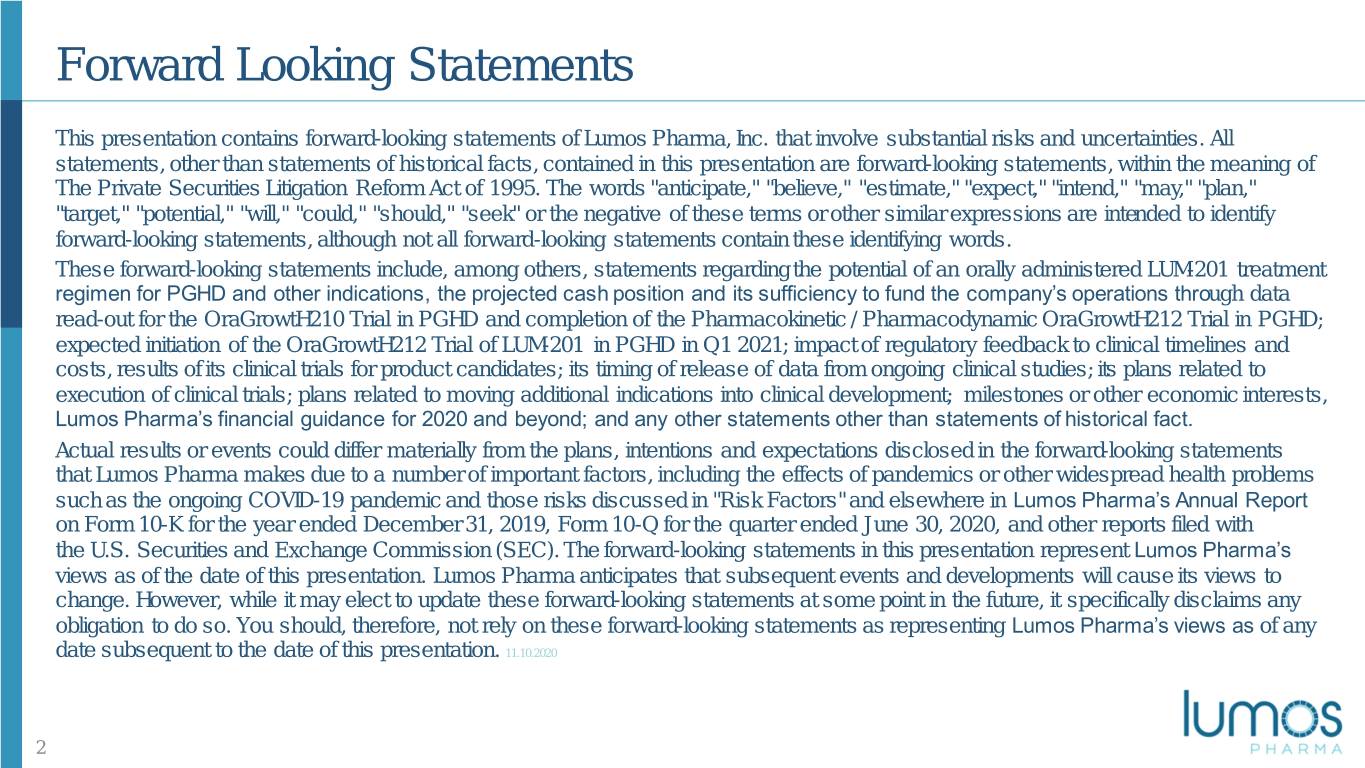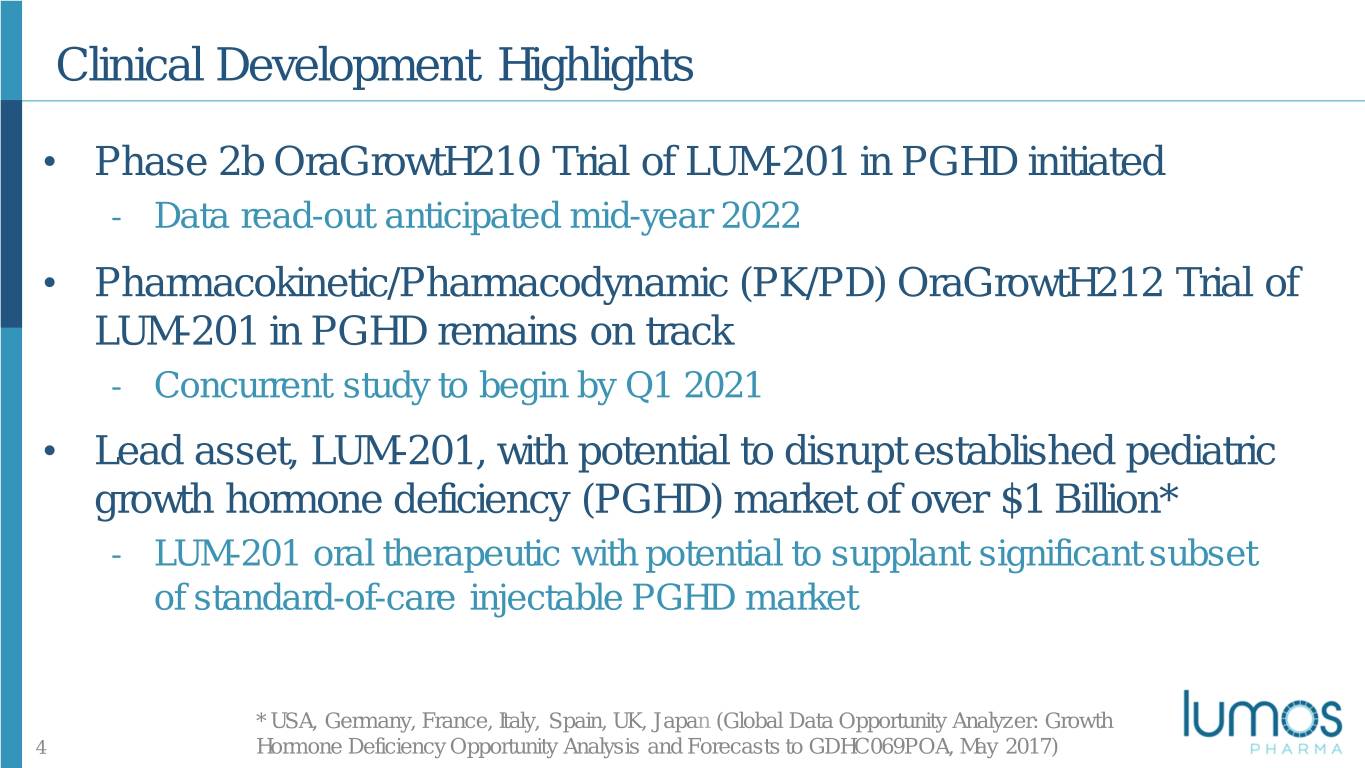Attached files
| file | filename |
|---|---|
| EX-99.1 - EXHIBIT 99.1 - LUMOS PHARMA, INC. | lumo-2020q3x8kxex991.htm |
| 8-K - 8-K - LUMOS PHARMA, INC. | lumo-2020q3erx8k.htm |

Third Quarter 2020 Financial Results and Corporate Update November 10, 2020

Forward Looking Statements This presentation contains forward-looking statements of Lumos Pharma, Inc. that involve substantial risks and uncertainties. All statements, other than statements of historical facts, contained in this presentation are forward-looking statements, within the meaning of The Private Securities Litigation Reform Act of 1995. The words "anticipate," "believe," "estimate," "expect," "intend," "may," "plan," "target," "potential," "will," "could," "should," "seek" or the negative of these terms or other similar expressions are intended to identify forward-looking statements, although not all forward-looking statements contain these identifying words. These forward-looking statements include, among others, statements regarding the potential of an orally administered LUM-201 treatment regimen for PGHD and other indications, the projected cash position and its sufficiency to fund the company’s operations through data read-out for the OraGrowtH210 Trial in PGHD and completion of the Pharmacokinetic / Pharmacodynamic OraGrowtH212 Trial in PGHD; expected initiation of the OraGrowtH212 Trial of LUM-201 in PGHD in Q1 2021; impact of regulatory feedback to clinical timelines and costs, results of its clinical trials for product candidates; its timing of release of data from ongoing clinical studies; its plans related to execution of clinical trials; plans related to moving additional indications into clinical development; milestones or other economic interests, Lumos Pharma’s financial guidance for 2020 and beyond; and any other statements other than statements of historical fact. Actual results or events could differ materially from the plans, intentions and expectations disclosed in the forward-looking statements that Lumos Pharma makes due to a number of important factors, including the effects of pandemics or other widespread health problems such as the ongoing COVID-19 pandemic and those risks discussed in "Risk Factors" and elsewhere in Lumos Pharma’s Annual Report on Form 10-K for the year ended December 31, 2019, Form 10-Q for the quarter ended June 30, 2020, and other reports filed with the U.S. Securities and Exchange Commission (SEC). The forward-looking statements in this presentation represent Lumos Pharma’s views as of the date of this presentation. Lumos Pharma anticipates that subsequent events and developments will cause its views to change. However, while it may elect to update these forward-looking statements at some point in the future, it specifically disclaims any obligation to do so. You should, therefore, not rely on these forward-looking statements as representing Lumos Pharma’s views as of any date subsequent to the date of this presentation. 11.10.2020 2

Lumos Pharma Q3 2020 Conference Call • Lisa Miller, Director of Investor Relations • Rick Hawkins, CEO Agenda • John McKew, PhD, COO & CSO • Eugene Kennedy, MD, CMO • Carl Langren, CFO 3

Clinical Development Highlights • Phase 2b OraGrowtH210 Trial of LUM-201 in PGHD initiated - Data read-out anticipated mid-year 2022 • Pharmacokinetic/Pharmacodynamic (PK/PD) OraGrowtH212 Trial of LUM-201 in PGHD remains on track - Concurrent study to begin by Q1 2021 • Lead asset, LUM-201, with potential to disrupt established pediatric growth hormone deficiency (PGHD) market of over $1 Billion* - LUM-201 oral therapeutic with potential to supplant significant subset of standard-of-care injectable PGHD market * USA, Germany, France, Italy, Spain, UK, Japan (Global Data Opportunity Analyzer: Growth 4 Hormone Deficiency Opportunity Analysis and Forecasts to GDHC069POA, May 2017)

Corporate Update • Received first tranche, $34 million, of $60 million total proceeds owed Lumos Pharma from PRV sale - Second tranche of $26 million anticipated January 2021 • PRV proceeds represent non-dilutive funds available for pipeline expansion - Pursuit of additional rare disease assets to expand portfolio - Targeting therapies where unmet medical need is high and pathophysiology is clear 5

PGHD and Standard of Care • PGHD occurs due to inadequate secretion of growth hormone by the pituitary gland during childhood • PGHD can be either hereditary or acquired, although the majority of cases have unknown causes (idiopathic) versus - Lack of physical growth is the most obvious manifestation; but numerous metabolic processes are also affected • PGHD incidence in U.S. approximately 1 in 3500 children1 • Standard of care consists of daily, subcutaneous injections of recombinant human growth hormone (rhGH) - Can be painful, potentially leading to missed doses and sub-optimal growth2,3 - ~2500 injections over years of treatment Robust, established market primed for an oral alternative 1 GlobalData EpiCast Report for Growth Hormone Deficiency Epidemiology forecast to 2026 2 Rosenfeld 2008 Endocrine Practice 6 3 Cutfield 2011 PLOS ONE

LUM-201 Mechanism of Action GHSR1a Hypothalamus • Oral LUM-201 is a growth LUM- hormone (GH) secretagogue SST GHRH 201 • Acts as an agonist of GH GHSR1a Secretagogue Receptor Pituitary (GHSR1a) to stimulate GH release1 • LUM-201 has been observed to GH increase the amplitude of endogenous pulsatile GH secretion2,3 • LUM-201’s stimulatory effect is regulated by GH/IGF-1 feedback IGF-1 SST somatostatin 1 Howard 1996 Science GHRH grow th hormone-releasing hormone IGF-1 insulin-like grow th factor-1 2 Nass 2008 Ann Intern Med 7 GHSR1a GH secretagogue receptor 1a 3 Chapman 1997 J Clin Endocrinol Metab

Targeted PGHD Population PEM-Positive: Included PEM-Negative: Excluded GHSR1a GHSR1a Hypothalamus HypothalamusIGF-1 SST GHRH LUM- SST GHRH LUM- 201 201 GHSR1a GHSR1a Pituitary Pituitary GH GH IGF-1 • Functional but reduced HP-GH axis • Non-functional HP-GH axis - Able to secrete some, but insufficient, GH - Unable to secrete GH - Expected to respond to LUM-201 - Not expected to respond to LUM-201 - Represents 50-60% of PGHD patients1 - Represents 40-50% of PGHD patients Predictive Enrichment Markers (PEMs): GH response to single LUM-201 dose and baseline IGF-1 have potential to distinguish these populations 8 HP-GH hypothalamic-pituitary-growth hormone 1 Lumos Pharma data on file

Clinical Development Outline for PGHD • Two main objectives set for Phase 2b OraGrowtH210 Trial - Prospectively confirm the utility of PEM strategy - Determine the optimal dose for Phase 3 registration trial • OraGrowtH210 Trial design - Three dose levels of LUM-201 (0.8, 1.6, 3.2 mg/kg) - Positive control arm of daily rhGH injections - Treatment-naïve, age-matched cohorts; 6-month dosing - Primary outcome measure: annualized height velocity (AHV) • Anticipate OraGrowtH210 Trial data read-out mid-2022 Generate safety and efficacy data to move on to Phase 3 study 9

OraGrowtH210 Trial Design • Primary endpoint of the trial: preliminary clinical validation of PEM strategy intended to select subjects likely to respond to therapy with LUM-201 - Assessed by the percentage of subjects defined as PEM test positive who have a positive growth response as measured by AHV from baseline to month 6 • Key secondary endpoints: - Selection of dose for use in future studies including Phase 3 based on comparison of 6-month AHV - Repeatability of the LUM-201 strategy in the classification of subjects as either PEM positive or PEM negative - Safety 80 subjects randomized among treatments arms for Phase 2b 10

OraGrowtH212 Trial: Pharmacokinetic / Pharmacodynamic Trial in PGHD • Purpose of Pharmacokinetics/Pharmacodynamic OraGrowtH212 Trial - Further explore LUM-201’s mechanism of amplification of natural pulsatile secretion of growth hormone - To expand data package in support of future regulatory filings • OraGrowtH212 Trial design - Two dose levels of LUM-201 - Single-site, 6-month, open-label study in treatment naïve PGHD patients - Concurrent with Phase 2b trial of LUM-201 in PGHD • Anticipate initiation of OraGrowtH212 Trial in Q1 2021 Generate additional data to support future regulatory filings 11

LUM-201: Other Potential Rare Endocrine Disorders • Beyond PGHD, Prader-Willi Syndrome Small for Gestational Age rhGH FDA approved in 2000 rhGH FDA approved in 2001 Lumos Pharma also plans to investigate LUM-201 for other rare endocrine disorders, for which rhGH has been approved Idiopathic Short Stature Turner Syndrome rhGH FDA approved in 2003 rhGH FDA approved in 1996 Significant opportunities with established regulatory pathways 12 GARD: Genetic and Rare Diseases Information Center

Secure Cash Position Metric Position Cash balance September 30, 2020 $105.6 million1 Second tranche of $26 million proceeds from Additional non-dilutive resources anticipated PRV sale expected in January 2021 Projected cash use per quarter through 2020 ~ $6.5 to $7.5 million Shares outstanding as of September 30, 2020 ~ 8.3 million Cash balance plus additional PRV proceeds to support current operations through OraGrowtH210 Trial read-out, OraGrowtH212 Trial completion, and contribute to pipeline expansion 13 1 Includes first tranche proceeds of $34m, less fees, from PRV sale

Lumos Pharma: Summary of Investment Thesis Lumos Pharma • Lead program, LUM-201, with potential to be the (NASDAQ:LUMO) first oral growth hormone secretagogue therapy Transforming Lives for PGHD with Rare Focus • Opportunity to disrupt established and sizable market • Management team with extensive experience in the clinical advancement of rare disease therapeutics • Cash balance plus additional non-dilutive funds from PRV sale expected to support current operations through planned OraGrowtH210 Trial read-out and OraGrowtH212 Trial completion, and to contribute to the expansion of Lumos Pharma’s rare disease asset portfolio Potential to significantly increase shareholder value 14
